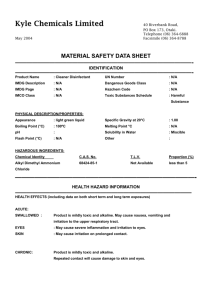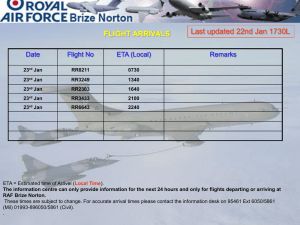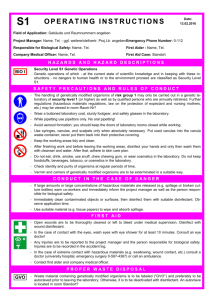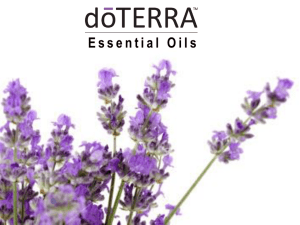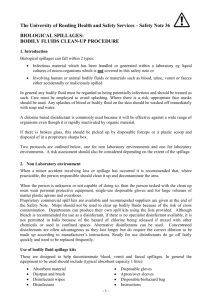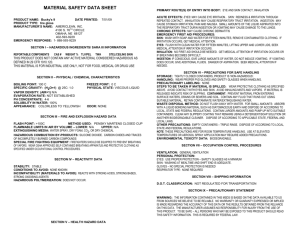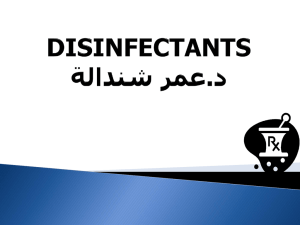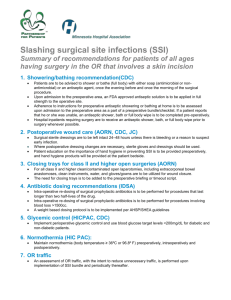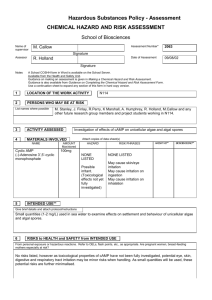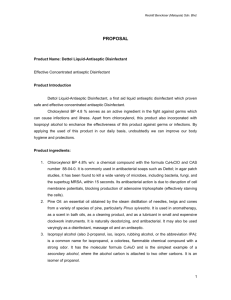A & D New Formula MSDS Datasheet 1
advertisement
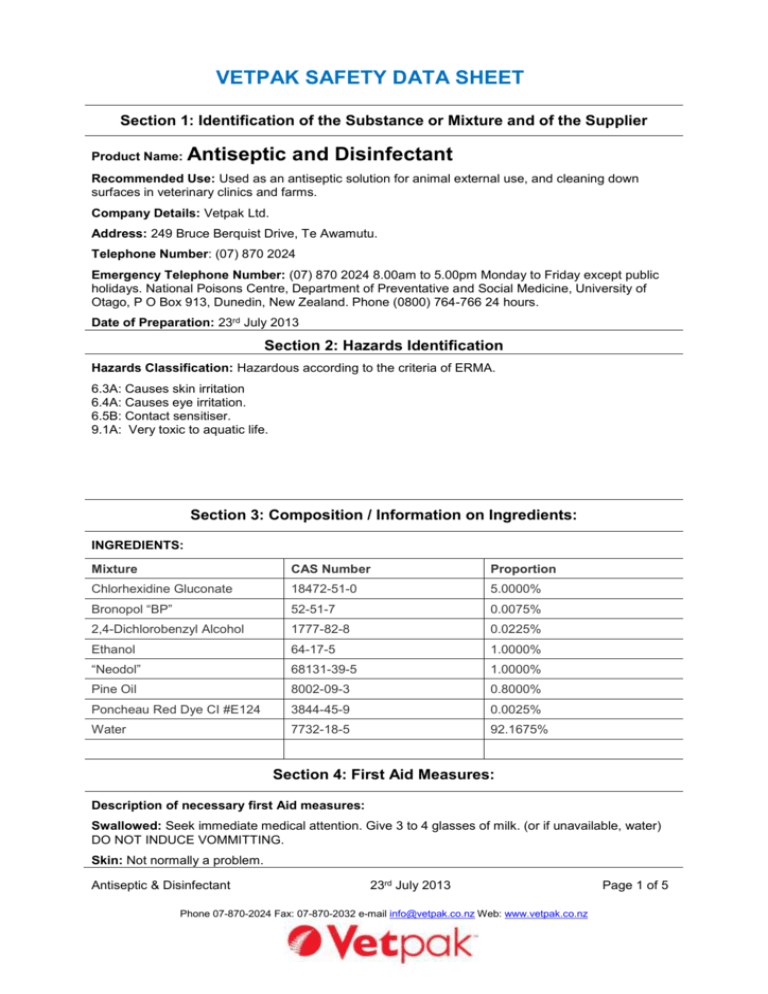
VETPAK SAFETY DATA SHEET Section 1: Identification of the Substance or Mixture and of the Supplier Product Name: Antiseptic and Disinfectant Recommended Use: Used as an antiseptic solution for animal external use, and cleaning down surfaces in veterinary clinics and farms. Company Details: Vetpak Ltd. Address: 249 Bruce Berquist Drive, Te Awamutu. Telephone Number: (07) 870 2024 Emergency Telephone Number: (07) 870 2024 8.00am to 5.00pm Monday to Friday except public holidays. National Poisons Centre, Department of Preventative and Social Medicine, University of Otago, P O Box 913, Dunedin, New Zealand. Phone (0800) 764-766 24 hours. Date of Preparation: 23rd July 2013 Section 2: Hazards Identification Hazards Classification: Hazardous according to the criteria of ERMA. 6.3A: Causes skin irritation 6.4A: Causes eye irritation. 6.5B: Contact sensitiser. 9.1A: Very toxic to aquatic life. Section 3: Composition / Information on Ingredients: INGREDIENTS: Mixture CAS Number Proportion Chlorhexidine Gluconate 18472-51-0 5.0000% Bronopol “BP” 52-51-7 0.0075% 2,4-Dichlorobenzyl Alcohol 1777-82-8 0.0225% Ethanol 64-17-5 1.0000% “Neodol” 68131-39-5 1.0000% Pine Oil 8002-09-3 0.8000% Poncheau Red Dye CI #E124 3844-45-9 0.0025% Water 7732-18-5 92.1675% Section 4: First Aid Measures: Description of necessary first Aid measures: Swallowed: Seek immediate medical attention. Give 3 to 4 glasses of milk. (or if unavailable, water) DO NOT INDUCE VOMMITTING. Skin: Not normally a problem. Antiseptic & Disinfectant 23rd July 2013 Phone 07-870-2024 Fax: 07-870-2032 e-mail info@vetpak.co.nz Web: www.vetpak.co.nz Page 1 of 5 VETPAK SAFETY DATA SHEET Eye: Immediately rinse eyes with running water. Remove contact lenses if easy to do. Continue rinsing for 15 minutes. Seek medical advice. Inhaled: If safe to do so, remove from exposure. Give artificial respiration if required. Seek medical attention immediately. Workplace Facilities: Eye bath and clean running water. Notes for Medical Personnel: Treat any symptoms symptomatically. Section 5: Fire Fighting Measures Type of Hazard: Not flammable. Fire Hazard Properties: None known. Extinguishing Media & Methods: Use the most appropriate of dry powder, foam, carbon dioxide (CO2) or water spray as extinguishing agent. Use the most appropriate extinguishing agent for surrounding hazards. Recommended Protective Clothing: Use protective clothing suitable for the surrounding fire. Section 6: Accidental Release Methods Procedures to be covered: Contain spillage using sand or sawdust. Mop, sweep or shovel spills into labelled containers for re-use or disposal. Dilute spillage with water and collect for disposal. Dispose containers and spills in an authorised landfill. If spillage enters drains, waterways or sewers, immediately notify the local and regional authorities. Section 7: Handling and Storage Handling: Transport upright in original labelled container with lid securely fastened. Handling Practices: Do not release the material to the environment. Store Site Requirements: No special store site requirements. Packaging: Store upright in the original, labelled container. Section 8: Exposure Controls / Personal Protection Workplace Exposure Standards: Composite Exposure Standard for mixture (TWA) (mg/m 3) 0.1mg/m3 Engineering Controls: General exhaust is adequate under normal operating conditions. Personal Protective Equipment (PPE): Wear eye protection if splashes are likely to occur. General hygiene: Do not eat, drink or smoke when handling this product. Antiseptic & Disinfectant 23rd July 2013 Phone 07-870-2024 Fax: 07-870-2032 e-mail info@vetpak.co.nz Web: www.vetpak.co.nz Page 2 of 5 VETPAK SAFETY DATA SHEET Section 9: Physical and Chemical Properties Physical State: Liquid. Appearance: Red free flowing liquid. Boiling Point: approximately 100ºC. Vapour Pressure: Not applicable. Specific Gravity: 1.00 (water = 1) Flash Point: Not flammable. Flammability Limits: Not flammable. Solubility in Water: Totally soluble. pH range: 7.00 – 8.0 Section 10: Stability and Reactivity Stability of the Substance: Stable under normal conditions of temperature and storage. Material to avoid: Avoid strong oxidising or reducing agents. Hazardous decomposition Products: Toxic organic vapours or fumes – amines, CO, CO2, nitrogen oxides, hydrogen chloride. Hazardous polymerization: Does not occur. Section 11: Toxicological Information Acute Effects: Swallowed: Accidental ingestion of the material may be harmful. Skin: The material is not thought to produce adverse health effects or skin irritation following contact. Good hygiene practice requires that exposure is kept to a minimum and that suitable gloves be used in an occupational setting. Eye: Direct contact with the eye may produce transient discomfort characterised by tearing or conjunctival redness (as with windburn). Inhaled: The material is not thought to produce adverse health effects or irritation of the respiratory tract. Good hygiene practice requires that exposure be kept to a minimum and that suitable control measures be used in an occupational setting. Long Term Effects: Not known to be teratogenic. Antiseptic & Disinfectant 23rd July 2013 Phone 07-870-2024 Fax: 07-870-2032 e-mail info@vetpak.co.nz Web: www.vetpak.co.nz Page 3 of 5 VETPAK SAFETY DATA SHEET Section 12: Ecological Information Potential Environmental Considerations: Very toxic to aquatic life. Data organisation: For Chlorhexidine chloride: Lepomis macrochirusBluegill LC50 MOR MORT --------FW 96 h----------S F 600, 479 - 771 ppb -----344 (ECOTOX) Daphnia magnaWater flea EC50 ITX IMBL --------FW 48 h----------S F 63, 32 - 102 ppb ------344 (ECOTOX) Environmental risk phrases: Collect spillage. Avoid release to the environment. Section 13: Disposal Considerations Disposal Information: Triple wash containers with water to use. Recycle if possible. Otherwise dispose empty containers by crushing and disposing in Council landfill. Section 14: Transport Information Relevant information: Transport upright in the original container with the lid tightly closed. Section 15: Regulatory Information Antiseptic & Disinfectant 23rd July 2013 Phone 07-870-2024 Fax: 07-870-2032 e-mail info@vetpak.co.nz Web: www.vetpak.co.nz Page 4 of 5 VETPAK SAFETY DATA SHEET Regulatory status: Exempt Section 16: Other Information Additional Information: National Poisons Centre, Department of Preventative and Social Medicine, University of Otago, P O Box 913, Dunedin, New Zealand. Phone (0800) 764-766 24 hours. 1. The above information has been compiled on the basis of good faith, and our experience from the available technical knowledge and data for this product. 2. Where health or safety data given discloses a risk to the user or environment, it is the responsibility of the Purchaser to pass on that information to employees or those who may be using the product, ensuring that adequate safety procedures are used. 3. No responsibility can be accepted for the wrongful or misinterpretation of this data. Antiseptic & Disinfectant 23rd July 2013 Phone 07-870-2024 Fax: 07-870-2032 e-mail info@vetpak.co.nz Web: www.vetpak.co.nz Page 5 of 5
